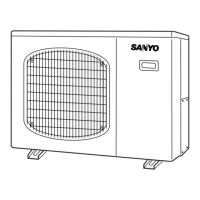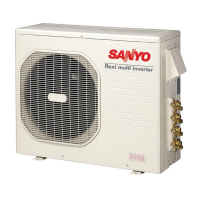
Do you have a question about the Sanyo SAP-CMRV1924EH and is the answer not in the manual?
| Brand | Sanyo |
|---|---|
| Model | SAP-CMRV1924EH |
| Category | Air Conditioner |
| Language | English |
Electrical safety precautions and wiring guidelines for qualified electricians.
Safe handling procedures for moving indoor and outdoor units.
Installation considerations for ceilings, walls, rooms, and specific locations.
Safety measures to follow before and during unit maintenance.
General safety advice regarding ventilation and refrigerant gas.
Detailed specifications for individual outdoor unit models.
Specifications for key components like compressor, fan motor, and heat exchanger.
Specifications for sensors and other auxiliary components.
Diagram illustrating the refrigerant cycle in the outdoor unit.
Data on unit performance across different temperature ranges.
Performance data specifically for the heating mode of operation.
Schematic diagrams detailing electrical connections for outdoor units.
Descriptions of the operational modes and features of the air conditioning system.
Information on built-in safety features and their operation.
Essential safety warnings and procedures before starting any inspection or repair.
Guidance on diagnosing faults using error indicator lamps on the control board.
Procedures for checking the operational status of the outdoor unit.
Troubleshooting guide for identifying issues in specific unit components.
Specific troubleshooting steps for diagnosing fan motor problems.
Key properties and handling considerations for R410A refrigerant.
Pre-service checks and considerations for working with R410A.
List of specialized tools required for servicing R410A systems.
Procedure for addressing and replacing a malfunctioning compressor.
Steps for detecting, repairing, and recharging after a refrigerant leak.
Guidelines for adding refrigerant to the system, especially when tubes are extended.
Information on adapting older units or tubing for R410A refrigerant.
List of tools necessary for installation that are not provided with the unit.
Inventory of accessories included with the air conditioning unit.
Details on optional copper tubing kits for connecting indoor and outdoor units.
Specifications for copper tubing and insulation material for system connections.
List of supplementary materials needed for completing the installation process.
Guidelines for selecting an appropriate location for the indoor unit.
Procedures for connecting multiple indoor units to the outdoor unit.
Recommendations for choosing a suitable installation site for the outdoor unit.
Diagrams showing the external dimensions of various outdoor unit models.
Illustrations detailing the recommended placement and spacing for outdoor unit installation.
Instructions for routing and securing refrigerant tubing and inter-unit wiring.
Guidance on installing drain caps and elbows for proper water drainage.
Explanation of the flaring technique used for connecting refrigerant tubes.
Step-by-step instructions for performing tube flaring using a flare tool.
Requirements for insulating refrigerant tubing to prevent heat loss and condensation.
Instructions for taping refrigerant tubes and associated wiring for protection.
Final steps for completing the installation, including sealing wall penetrations.
Procedure for removing air and moisture from the refrigerant system using a vacuum pump.
Key safety guidelines and precautions for electrical wiring.
Guidelines for selecting appropriate wire length and diameter based on local codes.
Diagrams illustrating the wiring connections between indoor and outdoor units.
Detailed steps for connecting wires to the unit terminals correctly.
Specific instructions for wiring the outdoor unit, including inter-unit cables.












